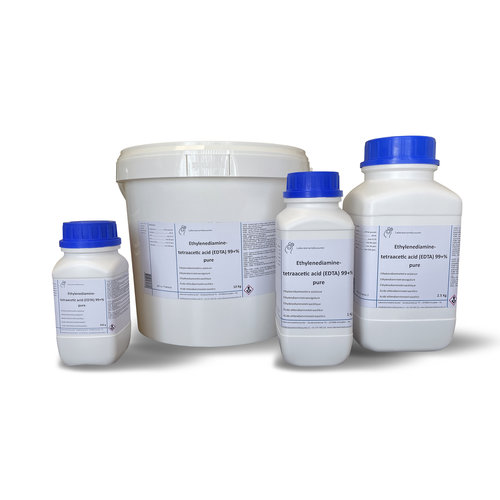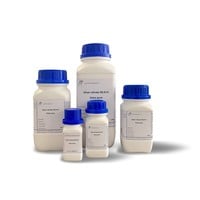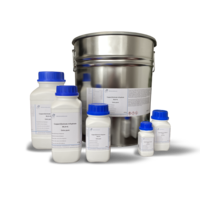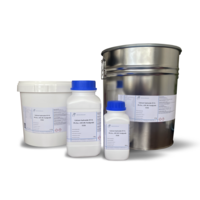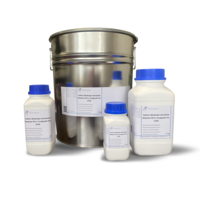You have no items in your shopping cart
Ethylenediaminetetraacetic acid (EDTA) 99 +%, pure
- Buy 6 and save 10%
EDTA (Ethylenediaminetetraacetic acid), or Editic acid, is a diamino tetracarboxylic acid with the formula C10H16N2O8.
EDTA has six basic sites, four correspond to the conjugate bases (carboxylates) of the carboxyl functions and two correspond to the amine functions. These base sites are also complexation sites, making EDTA a hexadentate (or sometimes tetradentate, when only the carboxyl sites are used) ligand. This is also its main characteristic, its strong chelating (or complexing) power which makes it form very stable metal complexes, making it a treatment in case of heavy metal poisoning such as lead at a suitable concentration. In complexes, EDTA is bound to metal cations as one of the conjugated bases. It was put together in 1935 by Ferdinand Münz
Applications
EDTA is used in many applications, for example in the paper industry, photography or the hygiene and food industry (antioxidant, preservative and sequestering agent E38512). EDTA is used to treat water (eg In detergents), to prevent deposits (limescale).
In chemistry, EDTA is used to test metal ions in solution (T.H.) by means of complexometry.
In biochemistry, EDTA is used as an inhibitor of metalloenzymes. It is very frequently used in the purification of nucleic acids (DNA or RNA) and proteins (see TAE buffer and TBE buffer). Specifically, by sequestering the magnesium Mg2 + ions, it blocks the activity of numerous nucleases that depend on this ion. EDTA is also an inhibitor of zinc metalloproteases and thus limits the hydrolysis of proteins in cell extracts.
In biological engineering, EDTA is routinely used to stop the activity of polymerases, where the chelation of magnesium cations (Mg2 +) alters the conformation of enzymes.
In medicine, EDTA, by forming iron (III) chelates, helps to combat hypersiderosis (tissue overload of iron). EDTA is also used in heavy metal poisoning, especially lead poisoning. A lead test known as "caused by calcidisoidal EDTA" makes it possible to confirm the diagnosis of lead poisoning more effectively than a classic blood or urine test, because it provides an index of the internal dose of biologically active and mobilizable lead. EDTA is also a preservative for eye drops, in combination with other preservatives such as thiomersal or benzalkonium chloride.
EDTA is also used as an anticoagulant, especially in blood tubes, as it traps Ca2 + ions, which are an important factor in clotting.
In dentistry, EDTA is used for endocanal demineralization during endodontic treatments.
In agriculture, EDTA is a chelating agent that can introduce certain nutrients into the plant. Adding EDTA to a soil helps combat micronutrient deficiencies.
In the food industry and cosmetics EDTA is used as a product stabilizer against degradation by bacteria (fermentation). Because the metal complexes of EDTA are significantly more stable than those derived from protein ligands, the metal cations become unavailable to the microorganisms for which they are essential, resulting in inhibition of bacterial growth.
In the nuclear industry (or after a nuclear accident), EDTA can be used for the manipulation16 or decontamination of radionuclides. Indeed, the chelation of radionuclides promotes their migration to the environment, including geologically during the final disposal of the waste (as opposed to the desired containment goal; for this reason the amount of EDTA per stored package is regulated by the waste acceptance criteria in most countries, and the use of non-complexing or non-chelating fumigants should be sought).
Technical data:
EDTA, Ethylenedinitrilo tetraacetic acid, Titration complex II
Empirical formula C10H16N2O8
Molar mass (M) 292.25 g / mol
Density approx. 0.86
Melting point (mp)> 220 ° C (dec.)
Solubility: approx. 0.5 g / l (H2O, 20 ° C)
WGK 2
CAS No. [60-00-4]
EC no. 200-449-4
$$$$$
Hazard statements
H319 Causes serious eye irritation
Safety recommendations
Precautions - prevention
P280 Wear protective gloves / eye protection.
Precautions - response
P305 + P351 + P338 IF IN EYES: Rinse cautiously with water for a period of time
amount of minutes; remove contact lenses, if possible; keep rinsing.
P337 + P313 If eye irritation persists: Get medical advice / attention.

%%%%%

